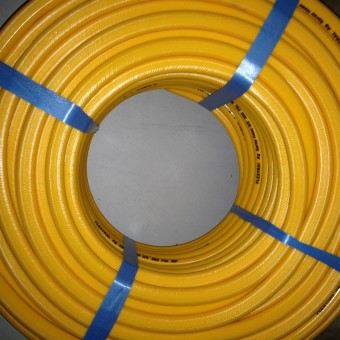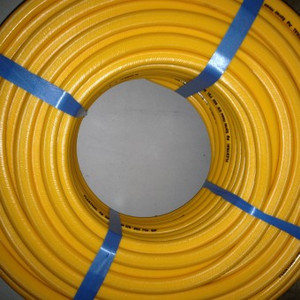With Spray Hoses: Too Much Is Not Enough
Posted by Andrew Greess on Jan 29, 2015
Considerations for power sprayer hose selection are:
Diameter
Most common weed and pest spray applications include 3/8 inch or ½ inch inside diameter (ID) spray hoses on power spray rigs. A
larger diameter hose delivers more volume. Larger hose costs more and is heavier to pull out and wind up. The weight can be a factor for the technician at the end of a long day. Some applications, such as termite pretreats or spraying tall trees, might require larger ID hose. Conversely, a smaller ID hose delivers less volume but weighs less and costs less than larger ID hose.
A smaller diameter hose results in more pressure loss because of increased friction of the water moving through the hose. If the application requires significant pressure, consider a larger ID hose. Examples of applications requiring higher pressure are spraying tall trees or having to throw water horizontally over a large distance – a nursery with large rows of trees, for example. (For a useful chart about calculating pressure loss, download a spraying guide at qspray.com/hypro.html.
Length
It’s risky to use words such as always or never because they often get you in trouble. When it comes to spray hose, it’s always better to have too much hose rather than not enough. If the hose is one foot too short, you can’t complete the job. Longer hose enables you to spray difficult-to-reach places. With a longer hose, when the hose end becomes damaged, it can be cut off without having to purchase new hose. The additional upfront cost of the extra hose is well worth the investment. If a longer hose is only used on rare occasions, put the extra hose on quick disconnects and attach it when needed. Spray hose usually comes in 200- and 300-foot rolls. Most suppliers are going to charge for the full roll, so there’s usually no benefit buying a partial roll.
Pressure
Be sure the hose has a burst pressure that significantly exceeds the maximum pressure rating of the spray pump you’re using. You don’t want the hose to burst and spill a chemical while spraying.
Cost and quality
Hose prices have increased recently because spray hose is made from petroleum products and transportation is a significant component of the cost. There are huge variations of hose quality and cost, so generalizations are difficult to make. Some hose remains flexible in cold weather, and some hose lasts longer despite being pulled across rocks or around corners of buildings. When you find a hose you like, stick with it. Less expensive hose that doesn’t last will cost more in the long run.
Problems
Wear
When the hose is showing significant wear – cuts, scrapes, gouges, etc. – fix it. Don’t wait for it to leak. It will cost much more in lost productivity to stop in the middle of a job,
drive to the repair shop and return to the jobsite. The first 30 feet of a hose is where it will break down first. When significant wear occurs, cut out the bad portion. This is another reason to start with a longer spray hose.

Temperature
Significant temperature extremes can reduce hose life. Whenever possible, protect hose from extreme heat and cold.
Pressure problems
Occasionally, spray hose can degrade pest sprayer performance. If everything appears to be working properly but you’re not getting any pressure, it could be a hose problem.If your hose is wound too tightly on the reel, the hose could flatten out and provide sufficient resistance so you don’t get the output you require. This condition might occur on some low-pressure, 12-volt electric pumps. To correct this problem, unwind the hose, turn on the pump and rewind the hose onto the reel less tightly. Another situation occurs when old hose becomes spongy. The hose expands, significantly reducing the pressure that can be achieved at the hose end. Replace the hose.
Policies and procedures
Technicians should run the hose through a rag while rewinding the hose onto the reel. This removes debris that can cut or damage hose.
Train technicians to inspect their spray hose, especially the first 30 feet or so, where problems are most likely to occur. A quick inspection for puddles under the reel will identify leaks on inner portions of hose. Encourage technicians to report problems and leaks, rather than living with them.
The inside section of the hose (closest to the reel) experiences the least wear. Periodically reverse the hose to extend overall life.
Provide technicians with hose repair kits so that temporary repairs can be performed in the field. This allows technicians to finish their route, before bringing the truck in for a more permanent hose repair. A repair kit consisting of hose mender, clamps, knife and screw driver can be inexpensively assembled.
Supervisors should perform regular truck inspections and check hose for wear and leaks. Buying the right hose, then preventing hose problems is a lot cheaper than chemical spills and downtime. A proactive approach to your hose will save you time and money.
Qspray is a professional pest control and landscape equipment business you can trust. We offer decades of experience, industry expertise and we stock all the hard-to-find parts for your spray equipment. Learn more about Qspray today.

